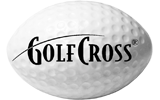Playing GolfCross

Golfcross is golf with goals instead of holes and while its oval ball gives you the control of a pro, the game itself demands that you think like one too. This is no easy game for hackers. The ball might be smart but you still need to be able to hit it cleanly. You need touch, accuracy, correct club selection and all the other things that make golf such a wonderfully challenging sport.
Above all you need a good grasp of shot shaping because golfcross will present you with new strategic problems and a tactical match play component that’s certain to add another dimension to your mental game.
With just a few exceptions and additions, golfcross uses the same rules as golf and has an identical scoring system. each shot counts. A quick read of the rules and the glossary at the end of the book will give you a good overall feel for how it works. The main difference is that you’re trying to hit a stable ellipsoid between eighteen sets of elevated uprights rather than an unstable sphere down eighteen holes. There are no greens and there’s no putting. But there are yards marked out round each goal. Land your ball inside the yard and you’re able to turn the goal to any one of three set positions. When you’re outside the yard you have to lay on to get turning rights or attack the goal in its facing position by going for a field goal. If you’re not in the goal zone you could take a punt and try to go in over the top.
Golfcross terminology may sound strange but essentially you’re still playing golf. It’s simply that the target is now more three dimensional and every shot is pretty much going where you want it to which is important because the fairways are narrow and there’s only one way into the goal.
Placing the Ball

The flight path of the oval golf ball is dependent on how it’s angled, so the rules of golfcross allow you to position it one foot from where it lies on the fairway or in the yard.
You can’t use the tee cup but the oval ball is easily held at all angles by the grass and natural indentations in the ground. If extra elevation is required, a pitch repairer makes a useful tool for bringing up the turf and building a natural tee.
The Goal
The goal is made of very flexible high tech materials which enable it to withstand extreme weather conditions. Its chain and position locator are of special importance to players.
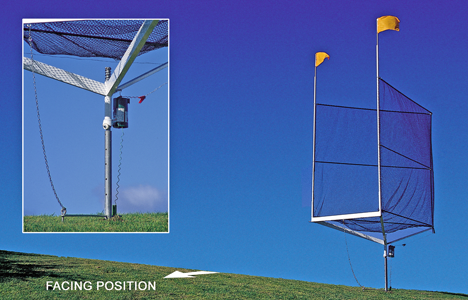
The chain, which runs from a clip under the crossbar to the ground, holds the goal in the facing position. This is the position the goal mouth is facing when you tee off. The goal remains in this position until your ball is in the yard and is returned to this position when shooting from outside the yard.
Laying the ball in the yard (inside the yard markers) is important because it gives you turning rights — the right to turn the goal mouth to one of three locked positions. These are held by a cog mechanism called the position locator and you can’t shoot for goal unless it’s locked with its wheel in a valley. The chain must be reclipped to the crossbar before players leave the yard. This returns it to the facing position ready for the next players.
With its clearly visible flagtopped uprights stretching four meters above the ground, the goal appears temptingly large. To most golfers used to a little hole and a pin, goaling out from anywhere closer than 100 yards looks like a distinct possibility. But hitting a ball through a target suspended in mid-air is very different from landing it on a ground-based target and calls for new levels of judgment.
There’s another problem that will also be new to golfers. Unlike the golf hole which can be attacked from all sides, there’s just one way into the goal from the fairway and it’s often only from a small area called the goal zone that a direct shot is possible. This area is marked with stripes on the course card along with the shape of the yard and the facing position of the goal so you know just what you’re up against before you tee off. The triangular goal is represented by a <. Its open end is the goal mouth in the facing position.
But not only do you need to carefully consider your angle of approach to the goal, you must also know where to land in the yard as there are shadows or shade areas between the three fixed goal mouth positions. From here only an oblique shot at a reduced target is possible.
Goal Technique
In the illustration, Red decides to take on the pond and rewards himself with a short approach to the yard which slopes away to the river behind. Blue plays a draw and flirts with the stream in order to allow a longer second shot to the goal zone.
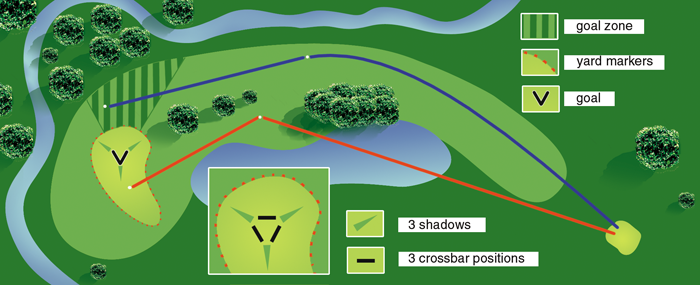
Both players must play their second approaches carefully. The closer Blue plays to the goal the smaller the goal zone becomes and the greater his chance of over or under shooting which will leave him with an oblique or no shot at all for his third. Red’s second shot, while shorter, must nevertheless land in a smaller area than Blue’s in order to get turning rights and he risks finding the shade at the back of the goal or going off the sloping yard and having to play back on.
Blue has the longer third shot and will target the pond side of the goal so as to avoid the slope and have plenty of yard to land in should he miss. If he does, he’ll need another stroke to come back on without any chance of a goal. Red’s third shot is oblique but there’s plenty of goal zone out the back provided he keeps right.
Which is all quite a lot to think about before you stop to consider what club to use and how you’ll position your ball. When really close to the goal (see rule 12) an out-to-in swing with an open faced wedge is the obvious choice. This shot requires a decisive follow through and you should first check that your swing is clear of the crossbar and that you are ready for a possible rebound.
The Punch Shot
There are two options when goaling out from farther back. Firstly, there’s the flat, forceful punch into the back of the net with the ball in the horizontal position. The big advantage of this shot is that difficult heightover-distance calculations can be dispensed with. All you have to worry about is direction. Failure, of course, may well see your ball bounding off the yard into big trouble.
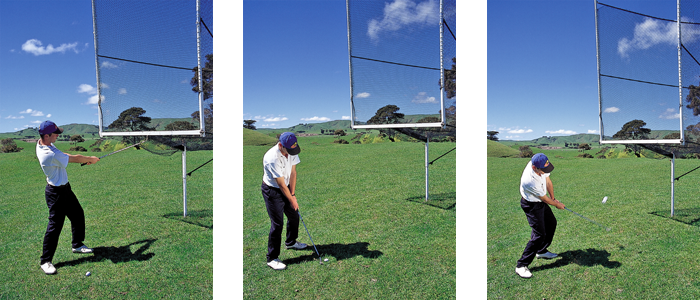
You also need to watch for wind billowing the net in on one side. This tightens the net and makes it springy enough to bounce a strong punch right out again.
The Coddler
Second is the coddler, a soft lofted shot with the ball positioned vertically or horizontally that falls gently into the basket.
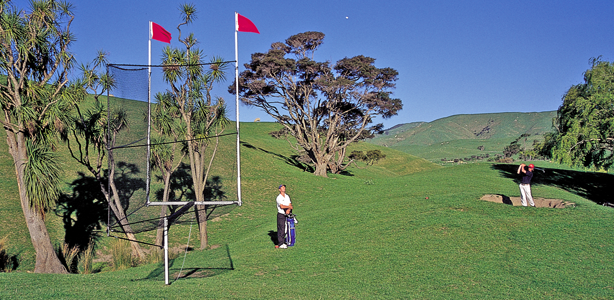
The advantage of this shot is that if it misses, the ball will stay in the yard. But it does require you to be on good terms with your wedge. This is one of the hardest shots to play and without doubt the most important in golfcross. Time spent working on it at the practice goal will be well worthwhile.
The Punt
Another shot worthy of practice is the punt. Because the goal has only one angle of approach you will often find yourself in a situation in which you are off the yard and only have a side view of the goal. The prudent course of action is to chip on and gain turning rights but for many golfers this approach will seem too timid. Instead they will take a punt and try to go in through the open top of the goal. It’s the ultimate shot in golfcross and golf’s equivalent of a flop shot off hardpan using a sixty-four degree wedge, and with only five feet of green to work with.
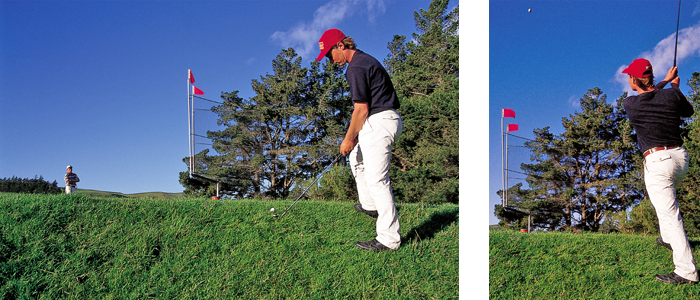
The degree of technical proficiency required is high and while many very good players will fail, they will at least play a lofted shot and it will fall safely at the base of the goal. Anyone less than good will be dicing with death. A poorly executed flop shot almost always has one result — a screaming shank that travels no more than a foot off the ground. But when the chips are down, taking a punt can pull you back from the brink of disaster. It’s the most formidable shot to have in your arsenal, and definitely the most satisfying of all to pull off.
Blocking Off
Equally satisfying is being able to turn against your opponent. Turning against, or blocking off as its better known, introduces a challenging tactical element to match play. It’s based on one of golf’s oldest rules — that the farthest away from the hole plays first.
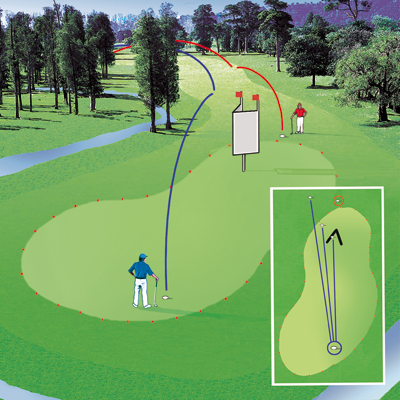
In the illustration, Red plays first because he’s farther away and secures a handy goaling out position just out-side the yard. Seeing Red’s position, Blue lays away, finds the yard and being at a greater distance from the goal, plays first. As he’s in the yard he gets the right to turn the goal to a favorable position. If he goals out, and here’s the rub, the goal will not be turned back to the facing position for Red when it’s his turn as it would be in stroke play. It must stay in its last position. Red will now have to take a country punt or play an extra stroke to get onto the yard and receive turning rights.
Blocking off puts a premium on finding the yard and gaining maximum distance off the tee in order to play second. It also tempts players to take risks.
Not only has Blue flirted with the stream at the back of the yard in the hope of forcing a block but by laying away he has also given himself a longer shot at goal. If he misses and remains in the yard, he needs another shot at goal and so loses the one stroke advantage. Worse still, there’s very little yard room at the goal end, so if he miscalculates direction or height he could run off the yard and be forced to play back to a goal that is now turned against him.
Clearly, golfcross match play calls for a calm nerve and the ability to think ahead.
